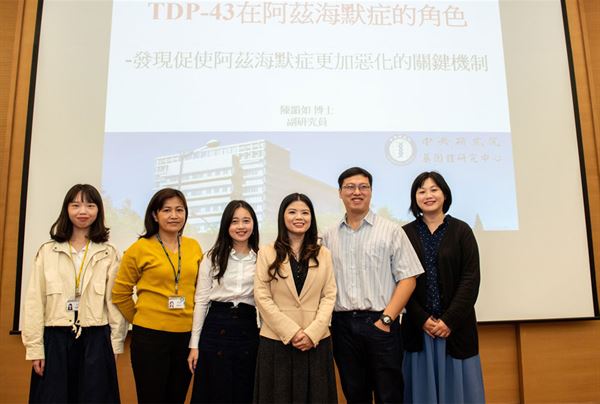Neurodegenerative diseases are making more impacts socially and economically as human life expectancy gets higher and higher. The scientific world still doesn’t have many clues regarding these diseases. Dr. Yun-Ru (Ruby) Chen’s research has been circled around the protein TDP-43 and its role in several neurodegenerative diseases, in a paper published in the journal Nature Communications, they have reported a new insight into how TDP-43 is affecting Alzheimer’s disease.
Disorders such as Alzheimer’s disease (AD), amyotrophic lateral sclerosis (ALS), and frontotemporal lobar degeneration (FTLD) all have the same problem, mainly, the nerve cells in brains are damaged and not reconstructable. Depending on the damaged location in one’s brain, the patient may have various corresponding cognitive and movement problems.
So far, two proteins found in patients’ brain tissue, Amyloid-β (Aβ) and Tau, are significant indicators of AD. In order to find treatment, scientists would like to find out what have caused these proteins to form in the first place.
In previous studies, Chen’s team has identified the fulllength TDP-43 protein molecule plays a significant role in ALS and FTLD. At that time, they had already noticed the possibility of TDP-43 having a role in AD since over 30-50% AD patients carrying TDP-43 inclusions in their brains. Continued with years of study and verifications, they have now proved TDP-43 indeed has a critical role in AD. By following this breakthrough, it is potentially feasible to come up with therapeutics to slow down the progression for such type of AD.
TDP-43 is an essential protein found in the nucleus that performs DNA and RNA related duties. Somehow, when they locate outside the nucleus, that is, into the cytoplasm, TDP-43 tends to create troubles.
It is a known fact that inside AD patients’ brain, Aβ generated largely from intracellular space, is a protein that accumulates to form plaques. Eventually, clusters of fibrils are formed, kind of like messy cords surrounding neurons in the brain. PET scanning for brain imaging to identify Aβ clusters is currently a means to verify AD disease.
However, emergent studies have observed a chemical substance during the fibril formation stage, this substance is called “oligomer” due to its smaller assembly. It turned out the oligomer is most toxic to the nerve cells. It appears the toxicity is making damages to the patient’s nerve cells and caused dementia, and fibrils are part of the end result when damages are already done.
In their study, the team has identified misfolded TDP-43 inside the neuron had interactions with the intracellular Aβ molecule to produce the Aβ oligomer.
In their tests, when TDP-43 is added to Aβ fibrillization process, TDP-43 would perturb and prolong the fibril formation process, and in the meantime, much more Aβ oligomers are induced. It is observed TDP-43 made more impact at the initial and oligomeric states, but not at the fibril state.
In one model of AD, they injected TDP-43 onto AD transgenic mice. The poor mice completely lost its way in a water maze. Compared to a control where the AD transgenic mouse was injected with buffer who found the hidden platform in the water maze in half a minute, it took the TDP-43 injected one more than a minute, and while it did bump into the isle, it could not recognize it at times. More neuron inflammation were found in the TDP-43 AD mice later in the anatomy.
The team also confirmed in human AD specimens, TDP-43 colocalized with Aβ in intraneuronal space.
The team designed and made several antibodies, they will look into a solution in finding a best antibody that can do a preempt act to interact with TDP-43. If less inflammation can be managed, less memory loss of AD patients could be feasible. A synergistic effect to disrupt TDP-43 and Aβ interaction may also ameliorate AD.
Dr. Chen indicated that it is still hard to anticipate the result on human with only mice model data. Nonetheless, as scientists unveil more truth, hope is always closer.
 |
| Team members(from left to right): Yeh-Tung Lin, Dr. Wei-Wei Chang, Ting-Yu Chang, Dr. Yun-Ru Ruby Chen, Dr. Yao Hsiang Shih, Dr. Ling-Hsien Tu |
The paper “TDP-43 interacts with amyloid-β, inhibits fibrillization, and worsens pathology in a model of Alzheimer’s disease” published in the journal Nature Communications can be read online at: https://www.nature.com/articles/s41467-020-19786-7


